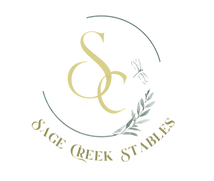How Turnout, Rest, and Recovery Impact Performance
- Sage Creek Stables

- Jul 26
- 3 min read

At Sage Creek Stables, we believe that excellence in the ring is built just as much outside the saddle as it is in it. In a world that prizes forward motion, we prioritize something even more powerful: intentional rest, thoughtful recovery, and high-quality turnout.
Whether you're chasing A-Circuit ribbons or developing a young prospect, your horse’s performance is only as strong as their wellness foundation. And that foundation starts with how—and how often—they rest, move, and recover.
Turnout: Movement with Purpose
Turnout isn’t a luxury—it’s a physiological necessity. Horses are built to move. Quality turnout gives them the opportunity to:
Stretch joints, tendons, and ligaments
Regulate digestion and hydration
Lower cortisol and increase endorphins
Reduce stall vices and tension patterns
At Sage Creek, we assess each horse’s temperament, fitness level, and social needs to design custom turnout protocols—from solo grass time to quiet buddy paddocks.
What to look for in elite turnout programs:
Clean, safe fencing with soft footing
Daily, consistent routines
Monitoring for behavior, shoes, and injuries
Access to shade, water, and natural foraging
Rest Isn’t Wasted Time—It’s Integration Time
Recovery doesn’t only happen overnight—it happens in the gaps between stress cycles. Without proper rest:
Muscles can’t rebuild
Neuromuscular patterns don’t settle
Emotional fatigue sets in
Learning is compromised
Our trainers use an intelligent scheduling model that considers:
Intensity of the previous day’s work
Upcoming goals (shows, clinics, etc.)
Age and conditioning of the horse
Emotional cues like sourness, tension, or refusal
Types of rest days we implement:
Walk-only sessions
Light hack/stretch rides
Full days off with turnout only
Non-mounted recovery modalities (TheraPlate, PEMF, etc.)
Recovery: The Often-Ignored Third Pillar
Many barns focus on “training and turnout”—but recovery is the third critical pillar.
We incorporate post-ride care into every training session, using tools like:
Cold therapy boots
Standing wraps
Tailored cooldown routines
Daily monitoring for soreness or swelling
Additionally, horses receive:
Strategic PEMF or LED treatments
Chiropractic or bodywork when needed
Adjusted grain and supplement routines during high-intensity cycles
It’s a system built not on reaction, but anticipation.
The Science Behind It
Research in equine sports medicine shows:
Horses need at least 12–16 hours of low-grade movement per day to maintain joint health
Muscles require 48–72 hours to fully recover from maximal effort
Elevated cortisol from overtraining negatively impacts immune function, digestion, and behavior
Our job isn’t to push through—it’s to build resilience over time.
Mind and Body Recovery
Rest isn’t just for the body—it’s for the brain.
Incorporating “off” time reduces:
Performance anxiety
Ring sourness
Learned resistance to pressure
Turnout and rest days help our horses process information, reset emotionally, and come back brighter.
What It Looks Like at Sage Creek
Here’s a sample weekly structure for a fit show horse in our program:
3 Training Rides (one jump school, two flatwork-focused)
1 Hack/Stretch Ride
2 Modalities (PEMF, TheraPlate, etc.)
1 Full Turnout/Rest Day
Each horse has a tailored plan, updated weekly in collaboration with trainers, grooms, and owners.
Final Thoughts: Performance Requires Pause
If you want to build a horse that competes at the highest level—safely, happily, and consistently—you need to prioritize recovery as much as work.
At Sage Creek, we don’t treat rest like a reward. We treat it like a requirement. Because the horses who last… are the ones whose teams listen when their bodies whisper—not just when they scream.
Want to Learn More About Our Wellness Approach? Reach out for a visit and see how we design individualized training and recovery plans for each horse in our care.




Comments